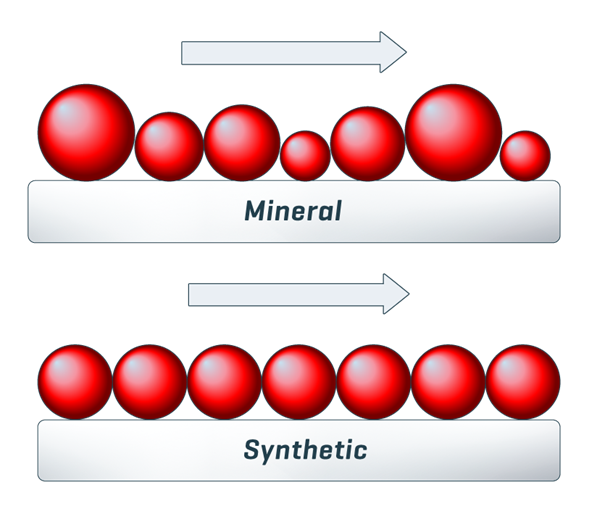Mineral oil: history or necessity

Mineral motor oils aren’t the highest performing lubricants, but without them it would be impossible to lubricate the different vehicles found on our roads!
Composition
The differences between mineral and synthetic engine oils originate from the base oils used within the formulations. Mineral lubricants use base oils which are obtained as a by-product from the refining of crude oil. Synthetic oils are created through further refining of mineral oils or through synthetisation of chemical components. As a result, mineral engine oils contain more impurities and the molecules differ more in size and shape than the ones found in synthetic oils, but they come with a lower price tag. Both synthetic and mineral engine oils are combined with additive packages to reinforce the lubricating properties of the final product and to tackle the specific needs of different vehicles.

Previous technology
Mineral oil based lubricants have been around for over a century while synthetic lubricants entered the market significantly later. On top of that, completely new and improved types of synthetic base oils, like synthetic esters, have been introduced throughout the years. So what are exactly the main advantages of these newcomers compared to mineral based oils?
The smaller molecules found inside mineral oil tend to burn quicker than the large ones, leading to an overall increase in viscosity. The final result is an engine that can’t run optimally and will see a loss in performance and engine protection! The intervals between mandatory oil changes are defined by the equipment manufacturers to make sure that the engine oil doesn’t degrade to an unacceptable standard. The quicker degradation of mineral oils is a factor which directly influences oil drain intervals, but it is definitely not the only one! Dirt collecting in the oil, degradation of the additive package and many other factors are taken into account by the vehicle manufacturers. Champion advises you to always follow the guidelines formulated by the vehicle supplier to protect your customers’ driving experience.
Then and now
A client having troubles with starting their engine during winter has entered your workshop? A mineral engine oil might be the cause of this nuisance. Mineral oils have a hard time retaining their fluidity at lower temperatures, resulting in more resistance when trying to get an engine running.
Back in the days, all engine oils were monograde, meaning that they could only be used at a specific range of temperatures. Too high or too low temperatures affected the viscosity of the oil to a level that it was completely unusable! Between summer and winter all vehicles had to come in for a mandatory oil change to assure complete engine lubrication.
Multigrade oils, which can be recognised by their name consisting of a number followed by W and another number (e.g. 0W30), have a wider applicability than monograde lubricants. These oils can be used during both winter and summer, greatly broadening their functionality. Both mineral and synthetic oils can be multigrade, but synthetic oils tend to stay completely operational over a wider range of temperatures compared to mineral oil, giving them a clear advantage!
The latest generation of engines and after-treatment systems require engine oils of the highest quality and purity and only a few types of powerful synthetic engine oil can fulfil these needs. This trend towards even more advanced lubricants are slowly pushing mineral oils out of the market, so why don’t we just already change to synthetic alternatives?
Mineral oil’s territory
Synthetic base oil may sound like the all-round solution but mineral oil has a few benefits you just can’t ignore:
- First of all, mineral oil is obtained as a by-product, meaning that the base oil doesn’t have to go through an additional refining process. This results in a less expensive base oil and a cheaper final lubricant.
- Secondly, there is the multifunctionality of mineral base oils. A wide range of vehicles are designed to be serviced with mineral oils, making these lubricants a great solution for your engine and your budget as long as you follow the car manufacturer’s recommendation. These vehicles will stay powerful and well protected thanks to properties of the mineral oils.
- Last but not least, mineral oils are unaggressive to most sealing materials present in vehicles. The detergents used within synthetic engine oils can be too powerful for the brittle seals of older vehicles, leading to leakage and lowered performance. A great example of mineral oil with extensive sealant protection is our Retro Formula 20W50, this mineral engine oil offers all-round protection for classic cars like the 1972 Ford Capri.
The debate about mineral or synthetic lubricants is becoming less important as engine oils are getting more and more diversified to suit the needs of specific engine types. This makes choosing the right engine oil for your next servicing job more complex and time consuming. But do not worry, Champion is here to help you find the ideal powerful lubricant within seconds! Champion’s Product Finder Tool automatically makes the connection between the vehicle on your bridge, its lubrication requirements and our product range. With just a few clicks you can see which engine oil, steering fluid, transmission fluid and other lubricants can be used to keep your customer’s vehicle in optimal condition.
Summary:
• The base oil found within lubricants can be mineral or synthetic
• A broad range of vehicles are designed to be serviced with mineral lubricants
• The latest vehicles can only be serviced with the right synthetic oils
• We expect to see a very slow evolution towards more synthetic engine oils in the market
• Use our Product Finder Tool to always find the perfect lubricant for the job